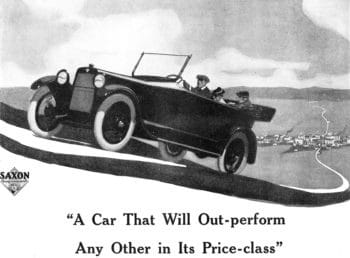DAVIDSON HISTORY
The Automotive Age

1916 advertisement for a Saxon
The automotive age arrived fairly early in Davidson. The first steam powered automobiles in the United States were produced by the Locomobile Company, founded in New England in 1899. According to Mary Beaty’s history of Davidson, the first Locomobile appeared in town only two years later, in 1901. Shortly thereafter, internal combustion engines came into use; even the Locomobile Company had switched to them by 1903.
According to Beaty, John P. Munroe had one of the early cars, complete with chauffeur, and Percival Hall used to drive his girl, Mary Young, around town in his sports car. By 1912, there were apparently enough cars in Davidson to warrant a speed limit, especially since the main road to Charlotte passed through the middle of town. The new limit was 12 miles per hour for horses, mules, and cars alike. According to the Davidsonian, in 1916 Davidson police chief John R. Johnston determined to enforce the limit, “took the numbers of about forty cars that were exceeding the speed limit, five of which were Davidson cars. The citizens of Davidson stand behind Mr. Johnston in his efforts, and it is hoped that the nuisance will soon be abated.”
According to Sumter’s Watchman and Southron, Davidson students had begun traveling back and forth to school by auto as early as 1912. An article published in December of that year reported that “Mr. Ervin Shaw, who is attending Davidson College, drove a car from Charlotte to this city on Wednesday afternoon, making the trip in about six hours. He was accompanied by Mr. John Duffle and three other Davidson students.”
For a number of years, Ben Beal had been operating a taxi service in town using horses and buggies. According to Beal’s reminiscences in the May 11, 1938 edition of the Davidsonian, “The trips would have to begin soon after lunch because at that time, if there was no trouble, it took at least four hours to make the trip…The road…was unpaved and in such terrible condition that there was constant danger of getting stuck.” Beal bought his first car, a Ford, in 1912, but “the trips were made in no better time for a while; for there was always at least four flats to fix before you arrived at your destination.”
According to the Davidsonian, by 1914 Avery Hobbs was the proud owner of a two-seater Ford, and Carlyle Sloan was operating a taxi service. Professor Harding bought a new Saxon in 1915, and his adventures were widely reported. On May 10, 1916, the Charlotte Observer reported that Dr. Harding, who “seldom overlooks an attraction in Charlotte,” had traveled back and forth to the Chautauqua in “his little vest pocket Saxon … There Is one advantage the doctor avers about the car and that is its ease of portage. When he reaches any particular bad stretch of road between Charlotte and Davidson it is alleged that he picks up the machine, thrusts it in his pocket and walks over to the next stretch of good road. If this be true the doctor is but following the custom of the French Canadian voyageurs who when they reached a particularly dangerous piece of rough water always benched their boats and lugged them around the falls re-embarklng below.”
In 1915, May Ellinwood of Connecticut, who had built a winter house on North Main Street around 1912, had added a garage in which to shelter her electric sports car.
Progress continued rapidly after that. According to the Davidsonian, by February 1916 an “auto bus line” had been organized by the United Motor Company to carry people between Charlotte and Mooresville. The bus, which stopped in Davidson en route, provided “a very attractive twelve-passenger Buick,” which made several trips a day. Davidson residents could travel to Mooresville for 10 cents, and to Charlotte for 50 cents.
By 1917 Jack Carter, seeing a business opportunity, had opened a garage where the CVS Pharmacy now stands. That same year, the town had its first recorded traffic accident. There was major progress in 1922. According to the Davidsonian, a contract was signed in September for a brick Ford agency and repair center on South Main Street across from Carter’s garage. That same month, W.A. Presson of Charlotte, who was to manage the agency, moved to town with his wife. Also, in September, work began on a new hard-surfaced road between Davidson and Charlotte.
By February 22, 1923 the Presson Motor Company, staffed by two salesmen and “three first class mechanics,” was in business. Since opening two weeks earlier, the agency had sold five cars and one tractor. The following month J.M. Blue opened a Chevrolet agency in town. In mid-November, the new Davidson College Highway was dedicated, providing “an already important artery of trade, connecting two of North Carolina’s most important business towns (Charlotte and Statesville), and embracing a number of smaller towns in which there is a great volume of business.” The new million-dollar highway raised hopes that tourists passing through town would stop and do business in Davidson.
All of this progress brought some very modern problems to town. By 1925 traffic had increased to the point where there was a major accident on Main Street after the Wofford football game. A Ford roadster, driven by an intoxicated driver, struck a Ford touring car, creating much excitement in town. Fortunately, the legal system had adjusted to these new challenges, and the driver was arrested for “driving a car on the state highway while intoxicated.”
Nancy Griffith
Nancy Griffith lived in Davidson from 1979 until 1989. She is the author of numerous books and articles on Arkansas and South Carolina history. She is the author of "Ada Jenkins: The Heart of the Matter," a history of the Ada Jenkins school and center.


